They were Universal’s “Twin Titans of Terror,” and during the first wave of horror movies, Boris Karloff and Bela Lugosi defined the genre. Of the six films they made together, the best are probably the first two, The Black Cat (1934) and The Raven (1935). Certainly, the first is the most twisted—to a degree that it’s remarkable that it got past the censors. At a brisk 65 minutes, it manages to include mass murder, Satanism, necrophilia, a human skinning and a chess game of death that beat Bergman by 23 years. The second, while a lesser film, is hardly lacking in outrageousness—of a kind that helped to provoke a moratorium on all horror movies the next year. And it’s all in the name of Edgar Allan Poe, whose short story and poem have nothing whatsoever to do with the films. (The films merely claim to have been “suggested” by Mr. Poe’s “immortal” classics. Poe’s opinion was not asked.)

The Black Cat is unquestionably the better film. In fact, it’s one of those horror movies that completely transcends the genre to simply be a great film on any basis. Everything about the film is beautifully controlled and brilliantly executed. The screenplay is as witty as it is dark, with its tale of a honeymooning mystery novelist (David Manners) and his wife (Jacqueline Wells). The couple become unwitting pawns in a game of death between an embittered and slightly unhinged psychiatrist (Lugosi) and the wholly evil leader (Karloff) of a Satanist cult. The acting is very fine. (This is almost certainly Lugosi’s best performance.) The all-classical musical score put together by director Edgar G. Ulmer and musical director Heinz Roemheld is perfect (and launched a generation of classical music fans). And then there’s the nonstop creativity of the direction itself. There really is nothing quite like it.
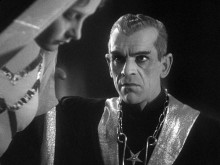
I’ve spent years dissecting The Black Cat and writing about it—in far more detail than I can possibly undertake here. Let me just say that it’s a film with unusually deep characterizations for both its stars. Lugosi’s betrayed and long-suffering Dr. Vitus Werdegast (returning from 15 years in a Russian prison, thanks to the Karloff character’s traitorous actions during World War I) is particularly fine—even, on occasion, deeply moving. Moreover, it’s a horror film that stands the traditional trappings of the genre on their head, since the bulk of the action takes place in the nightmarishly sleek, Bauhaus-inspired home of the treacherous Hjalmar Poelzig (Karloff), where even the Satanic altar has been given the modernist treatment. (That last probably helped sidestep the censors in terms of an inverted crucifix!)
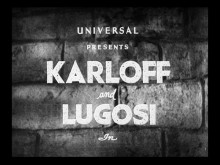
Louis Friedlander’s The Raven is something else again. Friedlander was promoted to this film from serials (presumably because Ulmer fell out of favor with the studio for running off with the wife of one the owner’s relatives). His background shows. Where everything was style on top of style in The Black Cat, here the stylistic flourishes are few and far between, limited to a clever camera angle here and there with a basic stand-‘em-up-and-shoot-‘em mindset more in evidence. As filmmaking, it’s nicely competent—most of the time. (It probably cannot be blamed on Friedlander that the credits mix up the roles being played by Ian Wolfe and Spencer Charters, and it’s unlikely he chose to re-use the music from The Black Cat and Werewolf of London (1935) for most of the film.)
As a Karloff-Lugosi film, well, that’s another matter, though this one should rightly be called a Lugosi-Karloff film, since Lugosi is in command of the film. (It’s no wonder that Karloff tended to talk down the movie in later years.) For the first and only time Universal afforded the simple “Lugosi” billing it had been giving to Karloff for some time, which was only fair, since there was never more than one of either actor (and never would be) and the solo last-name billing was all the audience needed to know.
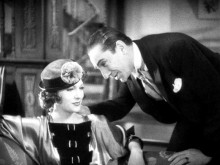
Lugosi plays Dr. Richard Vollin, ace surgeon, research scientist and Edgar Allan Poe fanatic with a penchant for building “those torture and horror devices that Poe described in his tales.” He’s also an egomaniacal loon who is just itching for a chance to use those devices. When his ego gets the better of him (“So they do say I am the only one!”), he agrees to operate on Jean Thatcher (Irene Ware) and save her from death due to a brain injury. He becomes smitten with his patient. It’s not entirely his fault, because Jean comes onto him so much that she registers as something of a willful tease. None too surprisingly, this doesn’t end well. So, of course, Vollin does what any loon would. He disfigures a gangster, Edmond Bateman (Karloff), to blackmail him into being his henchman so he can get his revenge on Jean, her fiancé (Lester Matthews) and her father (Samuel S. Hinds). No prizes for guessing with what instruments he plans to do this.
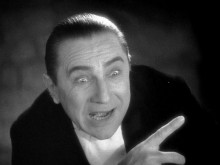
Lugosi is in his over-the-top element as Vollin—eyes blazing with madness and breaking into maniacal laughter with little provocation. He has a theory that he will become “the sanest man who ever lived” if he tortures these people to death (“I tear torture out of myself by torturing you!”). There’s little evidence to support this theory, since he gets crazier as the film zips along its brisk 62-minute running time. Indeed, by the end when Ian Wolfe’s character tactlessly remarks, “You monster! You like to torture!” Vollin veritably beams in response with, “Yes! I like to torture!” Well, nobody does crazy like Lugosi.
Seen today, The Raven is merely sadistic fun. At the time of its release, however, it became the number-one whipping boy for the case against horror movies’ very existence (Bride of Frankenstein ran a close second), and it was most often cited as the reason why such films should be banned. The case bore fruit, too, because in 1936 Hollywood placed a moratorium on the entire genre—one that would last until the falling revenues and the dictates of the markerplace said otherwise in 1939, by which time Lugosi had been driven to near poverty. It’s ironic that doing a thing too well should have caused Lugosi so much grief.
The Thursday Night Horror Picture Show will screen The Black Cat and The Raven Thursday, May 6, at 8 p.m. in the Cinema Lounge of the Carolina Asheville. Hosted by Xpress movie critics Ken Hanke and Justin Souther.



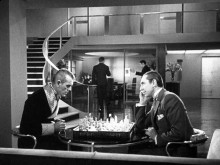
“Of the six films they made together, the best are probably the first two, The Black Cat (1934) and The Raven (1935).”
I think The Black Cat is the absolute best film Karloff and Lugosi made together, hands-down. The Raven, not so much. While Lugosi had a much smaller part in it than The Black Cat, I personally rank Val Lewton’s The Body Snatcher highly as well. I definitely think it among Karloff’s better peformances (although I haven’t seen all of his films.
I think The Black Cat is the absolute best film Karloff and Lugosi made together, hands-down. The Raven, not so much.
It’s not a great movie, but it’s great Lugosi and amusing Karloff.
I personally rank Val Lewton’s The Body Snatcher highly as well
Most people do. I have been trying to like it since I was in high school, but it just doesn’t seem to happen.
I’d like to thank everybody who showed up for the screenings of these movies. It was gratifying to find that, yes, there is an audience for 75 year old movies — and one that seems to like them and to get them both for what they were and what they are.